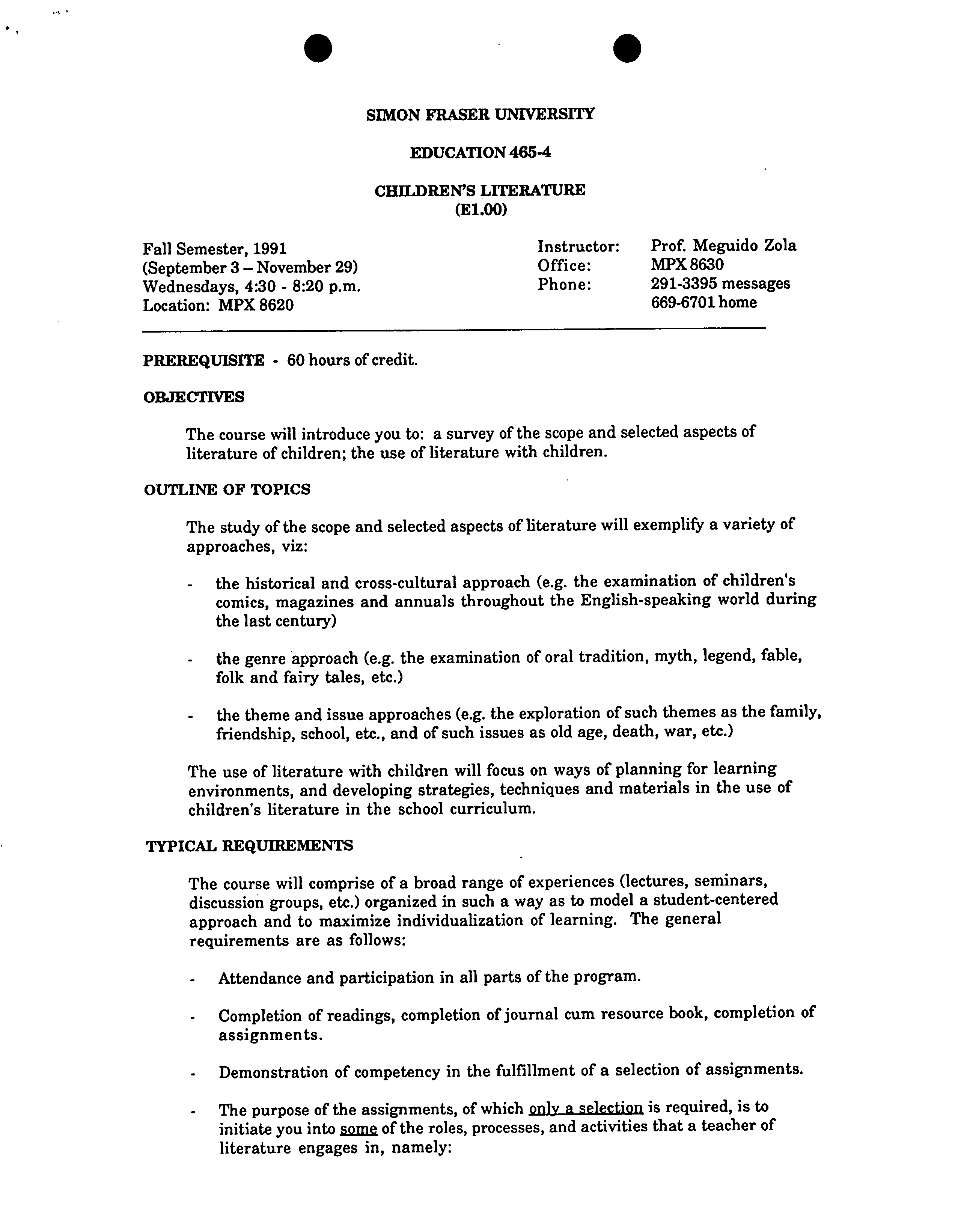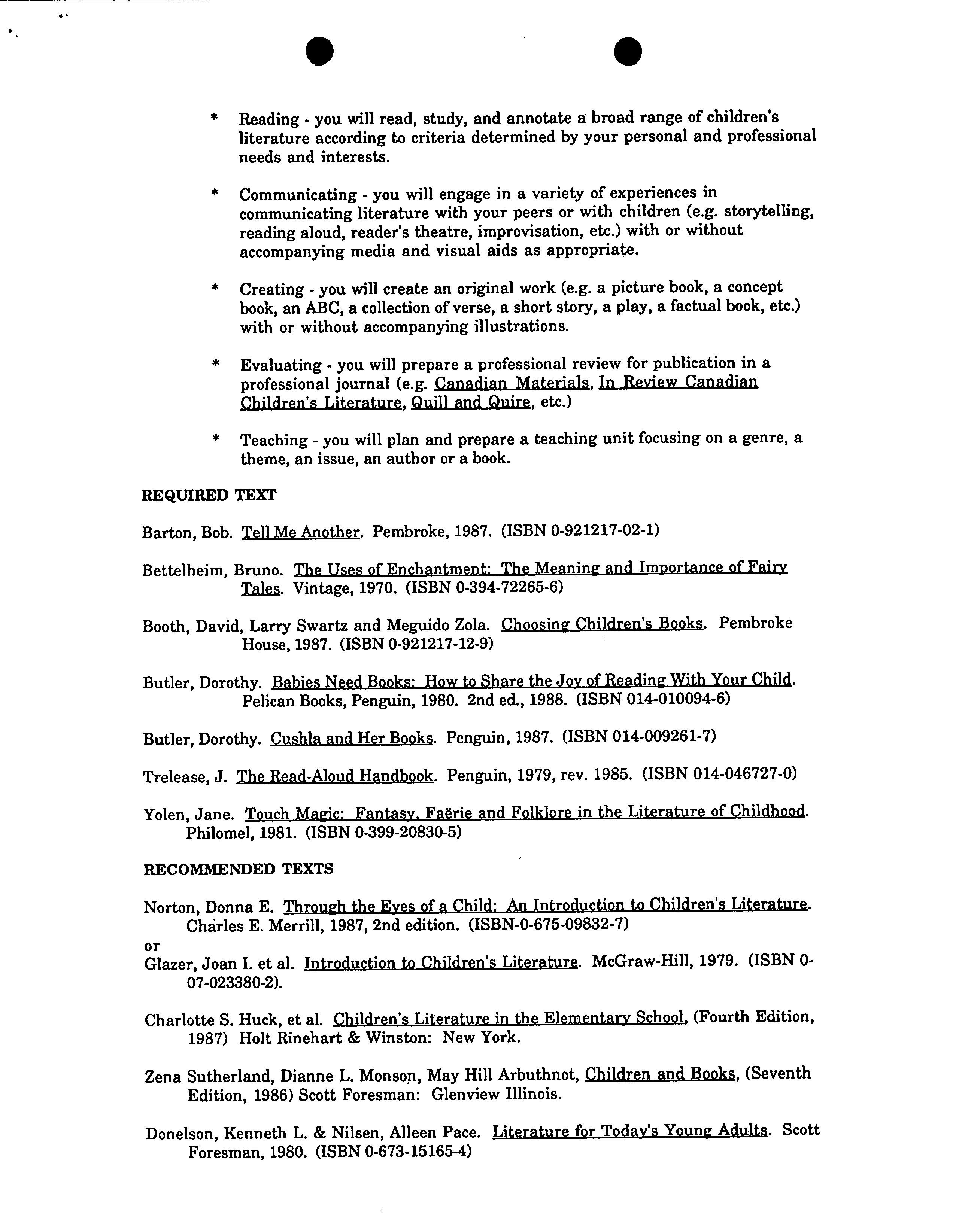.
?
.
Fall Semester, 1991
(September 3— November 29)
Wednesdays, 4:30 - 8:20 p.m.
Location: MPX 8620
SIMON FRASER UNIVERSITY
?
EDUCATION 465-4
CHILDREN'S LITERATURE
?
(E1.00)
Instructor:
Office:
Phone:
Prof. Meguido Zola
MPX 8630
291-3395 messages
669-6701 home
PREREQUISITE -
60 hours of credit.
OBJECTIVES
The course will introduce you to: a survey of the scope and selected aspects of
literature of children; the use of literature with children.
OUTLINE OF TOPICS
The study of the scope and selected aspects of literature will exemplify a variety of
approaches, viz:
- the historical and cross-cultural approach (e.g. the examination of children's
comics, magazines and annuals throughout the English-speaking world during
the last century)
- the genre approach (e.g. the examination of oral tradition, myth, legend, fable,
folk and fairy tales, etc.)
- the theme and issue approaches (e.g. the exploration of such themes as the family,
friendship, school, etc., and of such issues as old age, death, war, etc.)
The use of literature with children will focus on ways of planning for learning
environments, and developing strategies, techniques and materials in the use of
children's literature in the school curriculum.
TYPICAL REQUIREMENTS
The course will comprise of a broad range of experiences (lectures, seminars,
discussion groups, etc.) organized in such a way as to model a student-centered
approach and to maximize individualization of learning. The general
requirements are as follows:
- Attendance and participation in all parts of the program.
- Completion of readings, completion of journal cum resource book, completion of
assignments.
- Demonstration of competency in the fulfillment of a selection of assignments.
- The purpose of the assignments, of which only a selection is required, is to
initiate you into some of the roles, processes, and activities that a teacher of
literature engages in, namely:
r
* Reading - you will read, study, and annotate a broad range of children's
literature according to criteria determined by your personal and professional
needs and interests.
* Communicating - you will engage in a variety of experiences in
communicating literature with your peers or with children (e.g. storytelling,
reading aloud, reader's theatre, improvisation, etc.) with or without
accompanying media and visual aids as appropriate.
* Creating - you will create an original work (e.g. a picture book, a concept
book, an ABC, a collection of verse, a short story, a play, a factual book, etc.)
with or without accompanying illustrations.
* Evaluating - you will prepare a professional review for publication in a
professional journal (e.g. Canadian Materials, In Review Canadian
Children's Literature, Quill and Quire, etc.)
* Teaching - you will plan and prepare a teaching unit focusing on a genre, a
theme, an issue, an author or a book.
REQUIRED TEXT
Barton, Bob. Tell Me Another. Pembroke, 1987. (ISBN 0-921217-02-1)
Bettelheim, Bruno. The Uses of Enchantment: The Meaning and Importance of Fairy
Tales. Vintage, 1970. (ISBN 0-394-72265.6)
Booth, David, Larry Swartz and Meguido Zola. Choosing Children's Books. Pembroke
House, 1987. (ISBN 0-921217-12-9)
Butler, Dorothy. Babies Need Books: How to Share the Joy of Reading With Your Child.
Pelican Books, Penguin, 1980. 2nd ed., 1988. (ISBN 014-010094-6)
Butler, Dorothy. Cushla and Her Books. Penguin, 1987. (ISBN 014-009261-7)
Trelease, J. The Read-Aloud Handbook. Penguin, 1979, rev. 1985. (ISBN 014-046727-0)
Yolen, Jane. Touch Magic: Fantas y
. Faerie and Folklore in the Literature of Childhood.
Philomel, 1981. (ISBN 0-399-20830-5)
RECOMMENDED TEXTS
Norton, Donna E. Through the Eyes of a Child: An Introduction to Children's Literature.
Charles E. Merrill, 1987, 2nd edition. (ISBN-0-675-09832-7)
or
Glazer, Joan I. et al. Introduction to Children's Literature. McGraw-Hill, 1979. (ISBN 0-
07-023380-2).
Charlotte S. Huck, et al. Children's Literature in the Elementary School. (Fourth Edition,
1987) Holt Rinehart & Winston: New York.
Zena Sutherland, Dianne L. Monson, May Hill Arbuthnot, Children and Books, (Seventh
Edition, 1986) Scott Foresman: Glenview Illinois.
Donelson, Kenneth L. & Nilsen, Alleen Pace. Literature for Today's Young Adults. Scott
Foresman, 1980. (ISBN 0-673-15165-4)
Centre for Distance EStlon
Simon Fraser University
TC 3100 ?
291-3524
SFaculty of Education
Back to top
EDUCATION 465-4
CHILDREN'S LITERATURE
The two main purposes of this course are:
1.
To introduce you to a small representative sample of the range of literature
available to children today and to give you an opportunity to explore and
understand children's literature in greater depth, e.g. children's traditional
literature, folk and fairy tale.
2.
To introduce you to ways of bringing children and books together through such
strategies as: reading aloud, and other simple forms of presenting literature;
storytelling and dramatic presentation; setting up and running independent
reading programs.
PREREQUISITE:
60 credit hours, or permission of the instructor.
REQUIRED TEXTS:
Barton, Bob.
Tell MeAnother.
Pembroke, 1986.
Bettelheim, Bruno.
The Uses of Enchantment: The Meaning and Importance of Faity
Tales.
Vintage, 1977.
Booth, David, Larry Swartz and Meguido Zola.
Choosing Children's Books.
Pembroke House, 1987.
Butler, Dorothy.
Cushla and Her Books.
Penguin, 1987
Trelease,
Jim.
The Read-Aloud Handbook,2nd edition
Penguin Handbooks, 1985
TEXTS AVAILABLE ONLY THROUGH CENTRE FOR DISTANCE EDUCATION
Butler, Dorothy.
Babies Need Books: How to Share the Joy of Reading With Your
Child. (2nded.)
Pelican Books, Penguin, 1988.
COURSE REQUIREMENTS:
To complement your professional readings in the Study Guide and the texts, you will
be required to:
- read and annotate a broad range of children's books, according to course
guidelines and in the light of your needs and interests.
- engage in a variety of practical experiences with children; e.g. reading
aloud, storytelling, book talks and discussions.
COURSE INSTRUCTOR RESERVES THE RIGHT TO MAKE CHANGES WITHOUT NOTICE.



